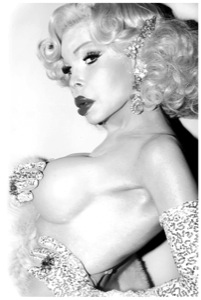
Given the historic nature of Coy Mathis’ victory, it would perhaps be fodder for media dissection long after the ruling came down. But, sandwiched as it was between some of the nation’s most transcendent moments in LGBT history, her story has all but disappeared from our collective national consciousness. Yet it bears repeating if we are to begin to understand just how remarkable Amanda Lepore’s place is in the narrative arc of the gay rights movement.
Coy Mathis was born six years ago as a boy, one of two other siblings born as triplets, to parents Kathryn and Jeremy Mathis of Fountain, Colo., a sleepy bedroom community just off the Ronald Reagan Highway, about 25 miles southeast of Colorado Springs. Unlike most children of her gender, however, Coy preferred dolls over trucks and pink over blue. Dressed as she was, in the colors of her liking, she was a gregarious, imaginative and contented child. But one day when Jeremy, an ex-Marine, tried to take her outside, Coy refused, adamantly insisting that she would only appear in public as she was, not how society expected her to be. And her parents agreed. What Coy was telling them, in her limited lexicon, was that she was born into the wrong gender and, in her own words, wanted to be “fixed.”
But in a letter dated June 18, the Colorado Division of Civil Rights found probable cause of discrimination when the Fountain-Fort Carson School District 8 banned Coy from using the bathroom she most identified with her gender. The reaction, as gauged by the vitriol in the comments sections of the many stories that were written about Coy’s predicament, was swift; vitriol seeping through the pages like blood from a deep gash through a poorly bandaged arm. It was not uncommon to see Coy described as a “freak” that needed to be reminded she had a penis. Her parents, far from immune, were roundly condemned by critics as “child abusers.”
But while there was no shortage of transphobia, what made this case so historic (and what makes its relative obscurity by the media and the greater public at large so disheartening) is her victory. She has unwittingly blazed a new path forward for other children, and there surely will be others, who suffer from what the medical establishment calls Gender Identity Disorder.
No longer will children in Colorado who identify with a different gender than the one they were born into have to navigate a hostile legal landscape that places additional psychological burdens for those who are already under assault by a society that is exactly where it was when gays and lesbians were making their first tentative steps out into the larger world around them.

Which brings us to Amanda Lepore.
If you follow New York City nightlife, including one that is first among equals, then Amanda Lepore is no stranger. Her presence is a well-established fact among A-listers, helped as it has been by her collaborations with world famous photographer David LaChapelle (his “muse”) and musical trailblazer Cazwell. Her signature features – those full, pouty lips and near-perfect mounds of grapefruit-sized breasts –are instantly recognizable by the trans community and her throngs of adorers in the wider straight and LGBT community at large. But before the cult classic videos like Cotton Candy and the MAC Cosmetics advertising campaigns and the invitations to Prides nationwide, Amanda Lepore, born Armand Lepore in Cedar Grove, N.J., was just like Coy, an oddity among those around, secure in what she wanted but lacking the vocabulary to express it. “When you get into the first grade, you realize there’s a boy’s gym and a girl’s gym and I just naturally wanted to go with the girls,” shared Amanda. But like so many others trapped inside bodies they wished they could shed, the internal struggles were matched by an intense cruelty that could only be found in her external struggles. “It was sad. I was forced to be in a masculine role and that’s when it would get more depressing. I was a feminine kid and people would make more fun of me.” But unlike the world Coy has found herself in, there were no Transgender Legal Defense and Education Funds to support and defend Amanda.
By ten, Amanda discovered what hormones were and throughout the rest of her teens she travelled a path that, even by today’s standards, is remarkable to say the least. She befriended another outcast at school, a self-described “bad girl,” and through a series of introductions at her friend’s job (as a go-go dancer, naturally), she met someone who supplied her with hormones, on the condition that Amanda not tell her parents (she was 15 at the time), and continued to do her makeup and provide her with costumes.
The hormones took their course and soon Amanda was developing breasts, a fact that did not escape her parents who, as the remote adult figures in her life, seemed resigned to Amanda’s unusual trajectory. At 17 she met a man she would later ‘marry’ – though not without the sort of Sturm und Drang you might expect when boy meets girl, boy falls in love with girl, boy discovers girl was once a boy – and through the financial largesse of her boyfriend’s father, was able to complete her transition.
Given that background, Amanda was asked what her message would be at this year’s San Diego Pride where those who are beginning to develop a sense of their otherness or who have already grown into their own skin will never come close to leading the glamorous life of an Amanda Lepore; an island unto itself, shielded from the pedestrian savagery of a world still struggling with gays and lesbians? “One message is that people can be themselves with me. Transexuals or gays and lesbians or straight guys. It doesn’t have to be ‘tragic.’ It could have been horrible but people liked it and accepted it even if it was an unusual situation. That people who feel insecure or different can feel strong enough to be who they are and to go with it. And I think I give them strength in that and that’s the success in what I have to say.”
Amanda Lepore, direct from New York City, will be appearing at this year’s San Diego Pride Festival on the main stage Saturday, July 13 from 3:30-4 p.m.











